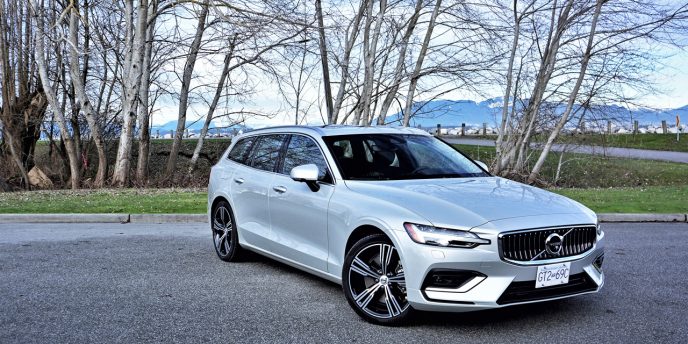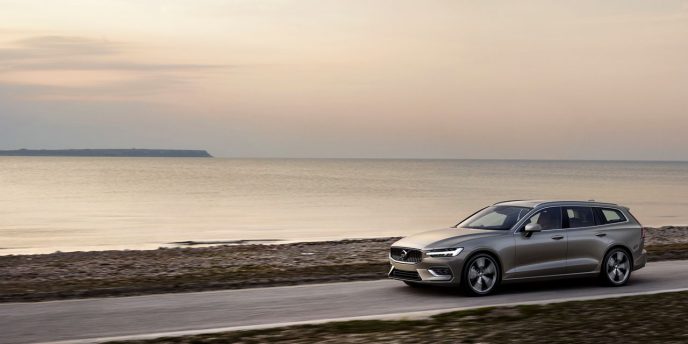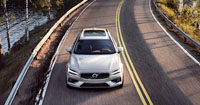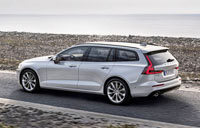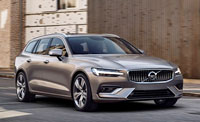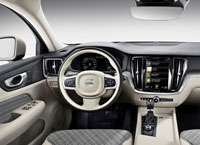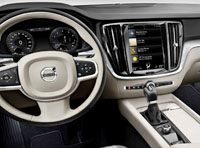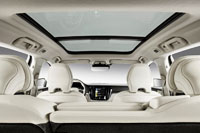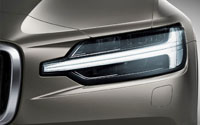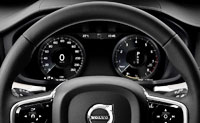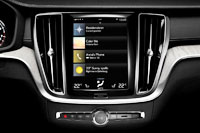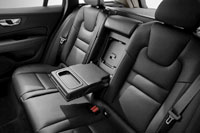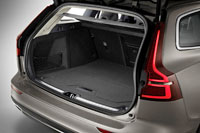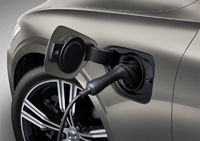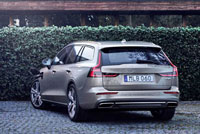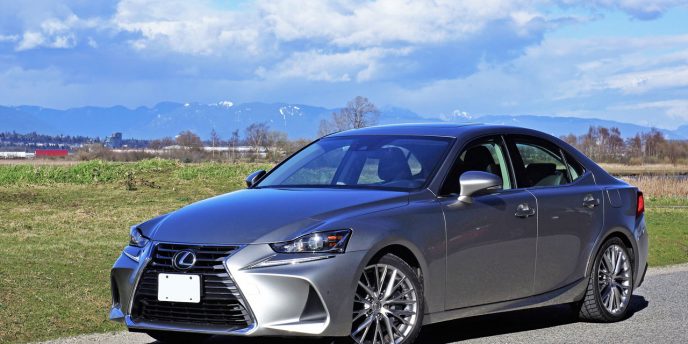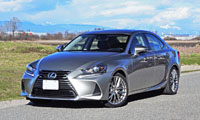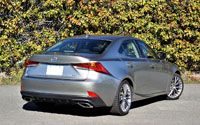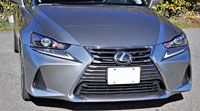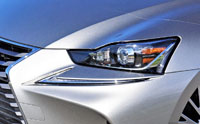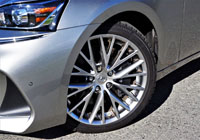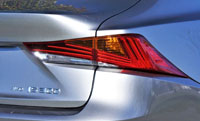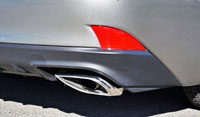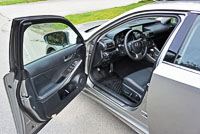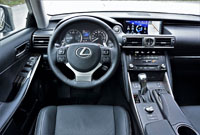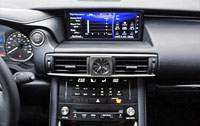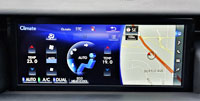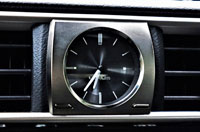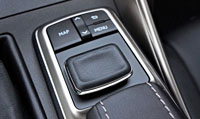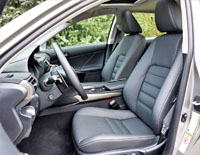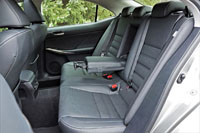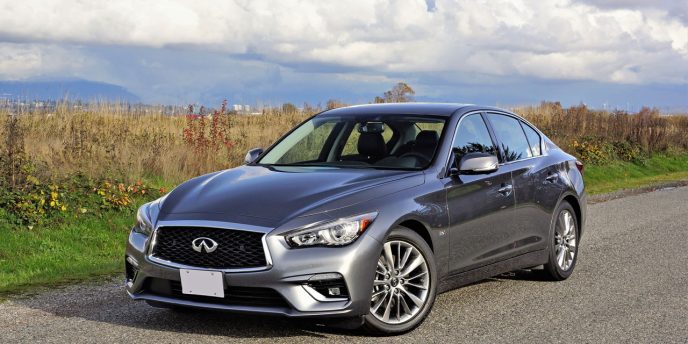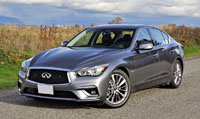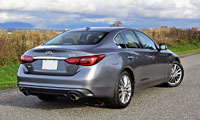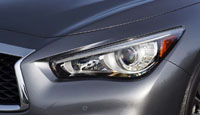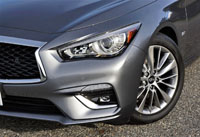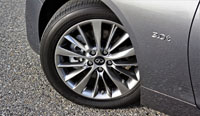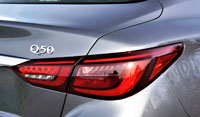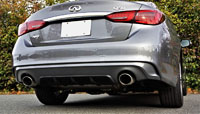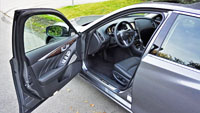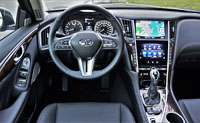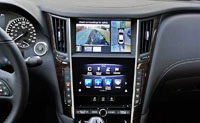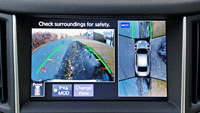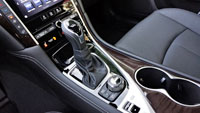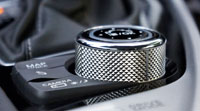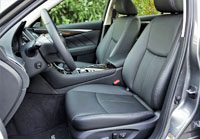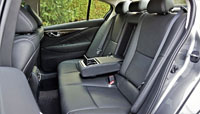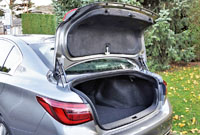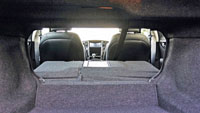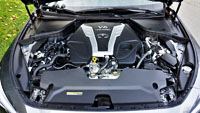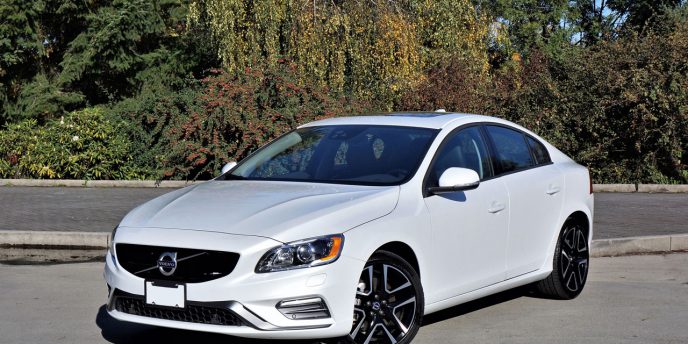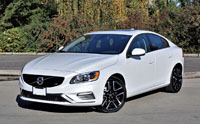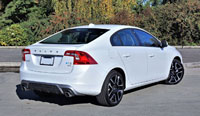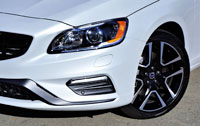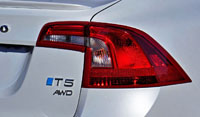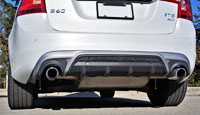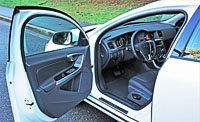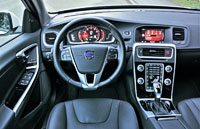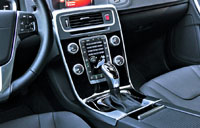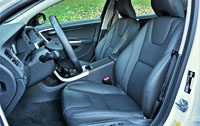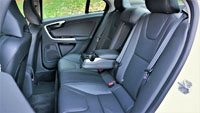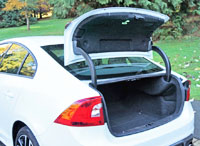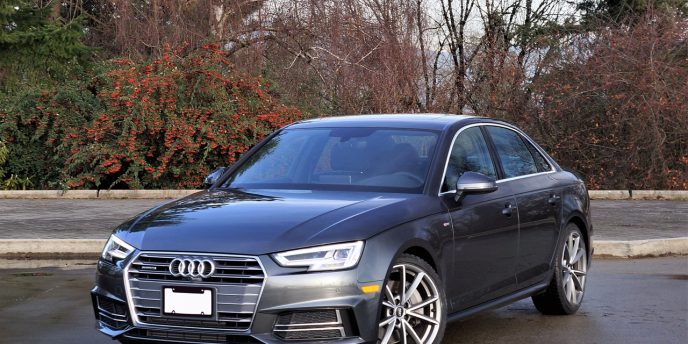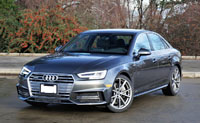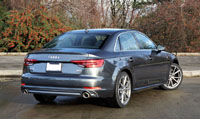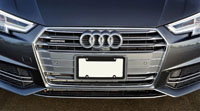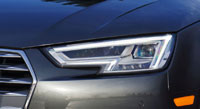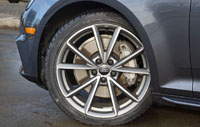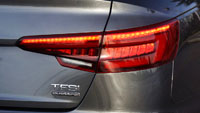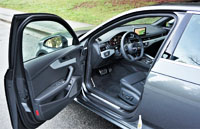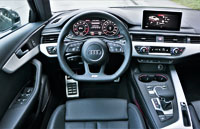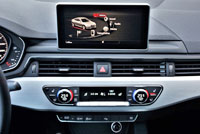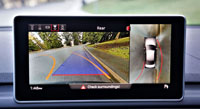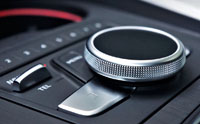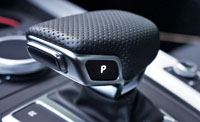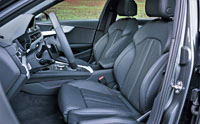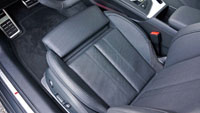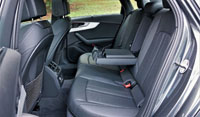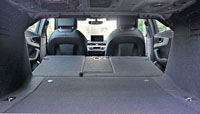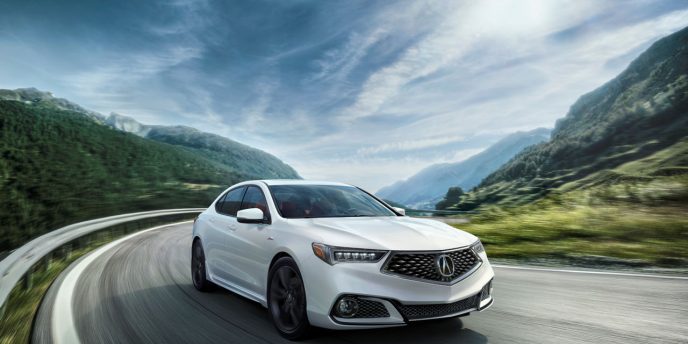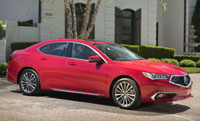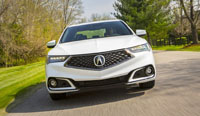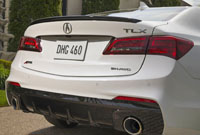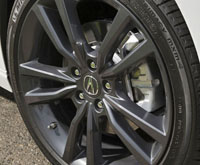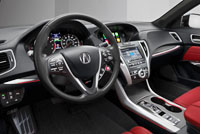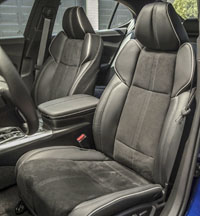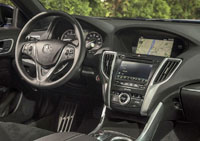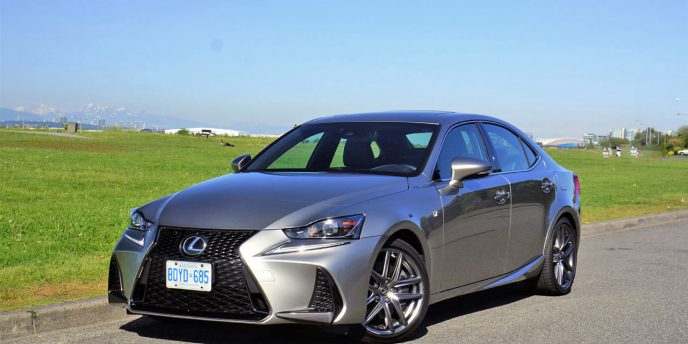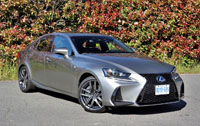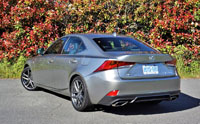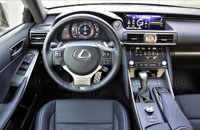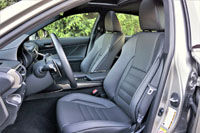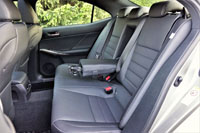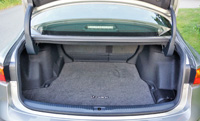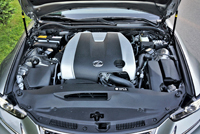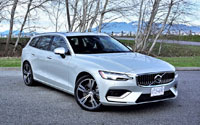
Hey wagon lovers! Take a look in our garage this week. This is the entirely new-from-the-ground-up 2019 Volvo V60 in top-line Inscription T6 AWD trim, which means that it looks fabulous, comes filled with all of Volvo’s latest non-plug-in tech, and is one luxurious family hauler.
It’s also really roomy. In fact, we think the new V60 is targeting previous V70 customers just as much as those who loved the outgoing V60, thanks to a substantive 124-mm (4.9-inch) greater length overall, plus a 9.6-mm (3.8-inch) longer wheelbase that results in the most spacious rear seating area in the luxury D-segment. The new model is 51 mm (2.0 inches) lower than its predecessor too, which adds to its long, sleek visual stance, but nevertheless it provides ample headroom and legroom for a six-foot passenger behind a six-foot driver, or so reports claim, while the new V60 also boasts 20 percent more cargo room than the outgoing car.
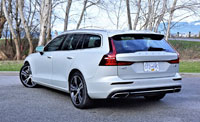
The new V60 sits atop the same Scalable Product Architecture (SPA) chassis architecture that underpins the larger V90 sport wagon, not to mention everything else in today’s Volvo lineup other than the compact XC40 crossover that utilizes the brand’s new Compact Modular Architecture (CMA) platform, which incidentally will support a new 40 series line of cars in the near future. SPA and the models built upon it have been widely praised by auto critics like us and Volvo customers alike, while sales of new Volvo products have been skyrocketing since the brand’s transformation that started with the second-generation XC90 SUV back in 2015.
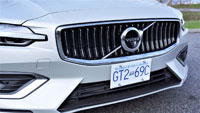
We’re not expecting this V60 sport wagon to sell anywhere near as well as that XC90 mid-size SUV or the more recently introduced XC60 compact crossover SUV, or for that matter the new V60 Cross Country that adds a little more off-road flair via the way of a raised suspension and rugged looking matte black body cladding, but the regular V60 should provide more road-hugging handling prowess, which we’ll report on later in our upcoming road test review. Big sales or not, the V60 supplies a major dose of Volvo DNA to the entire brand.
After all, Volvo has had a wagon in its lineup longer than most people can remember, and now that the larger V90 has been slated for cancellation in Canada (it was only ever available via special order in the U.S.), availability of this V60 is critical for keeping up the Swedish brand’s pragmatic image.
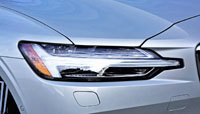
Pragmatic yes, but sitting down inside replaces any such practical thoughts with feelings of pampering hedonism, being that the 2019 V60 continues Volvo’s new brand ethos of providing more luxury than any rival. We won’t tell you all of our experiences yet because we’ve only taken delivery of the car and haven’t even written our notes down, but being that it looks much like everything else from the Swedish carmaker we’re expecting to find more soft-touch surfaces, satin-silver trim, jewellery-like detailing, and genuine hardwood inlays than rivals from Germany, Japan or the U.S., while Volvo’s electronic interfaces are some of the best in the business, from its standard 8.0-inch digital driver display within the gauge cluster to the optional 12.3-inch version of those same primary instruments, not to mention its standard 9.0-inch tablet-style Sensus centre-stack touchscreen.
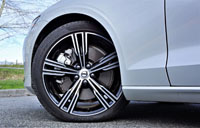
Volvo’s Sensus touchscreen has become our go-to example of how to do infotainment systems correctly, thanks to incorporating one of the most user-friendly and feature-filled interfaces in the auto industry. The new V60’s boasts 50 percent faster processing speeds than previous iterations used in other models resulting in quicker startup, faster response from the backup camera, much improved voice activation, and speedier navigation route calculation. The standard backup camera includes dynamic guidelines and graphics for the standard rear parking sensors, while other standard functions include Apple CarPlay and Android Auto smartphone integration, 4G LTE in-car Wi-Fi, a 10-speaker 330-watt audio system, satellite radio, a four-year subscription to Volvo On-Call that features remote start and vehicle tracking, and lastly two standard USB charging ports.
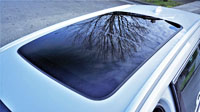
The base 2019 V60 Momentum T5 FWD starts at just $43,900 plus freight and fees, which is only $50 above than last year’s base V60 despite its all-new design and upgraded everything, including those aforementioned “Thor’s Hammer” LED headlamps. Additional standard features include 18-inch alloy wheels, metal door sill treadplates, rain-sensing wipers, a powered panoramic glass sunroof, an auto-dimming rearview mirror, a three-spoke leather-wrapped multifunction steering wheel, dual-zone automatic climate control with a Clean Zone Air Quality system and a humidity sensor, unique Iron Ore decor inlays, Moritz leather upholstery, power-adjustable heated front seats with two-way powered lumbar support and driver’s memory, a 120-volt household-style power outlet in the rear console, a powered liftgate, power-folding rear seat headrests, power-folding rear seatbacks with controls in the cargo compartment, a semi-automatic cargo cover that conveniently slides up and out of the way when opening the tailgate, a metal cargo scuff plate, black integrated roof rails, dual chromed tailpipes, and more.
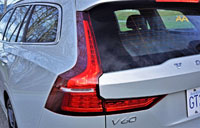
This being a Volvo means plenty of safety gear comes standard too, so therefore all 2019 V60 trims get City Safety automatic front collision warning with full low- and high-speed autonomous emergency braking, plus Driver Alert Control, steering support, Run-Off Road Mitigation, Lane Keeping Aid and Oncoming Lane Mitigation, as well as all the usual active and passive safety features including an airbag for the driver’s knees, front seat whiplash protection, and pyrotechnical seatbelt pretensioners in all positions front to rear.
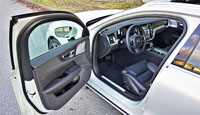
Of special note, the 2019 V60 introduces a new Oncoming Braking system to the entire Volvo lineup, which if sensing an imminent head-on collision will automatically actuate maximum braking force two-tenths of a second before impact. This is said to reduce vehicle speed by 10 km/h ahead of an impact, which could potentially be a lifesaver and certainly help to minimize life-altering injury.
Momentum trim is available with the choice of two powertrains, the first being the T5 FWD that consists of Volvo’s well-proven 2.0-litre direct-injected and turbocharged engine, good for 250 horsepower and 258 lb-ft of torque, and the second the T6 AWD that costs an additional $4,000 for a total of $48,900 yet adds a supercharger to the turbocharged four-cylinder resulting in 316 horsepower and 295 lb-ft of torque. The former allows for a zero to 100km/h sprint of 6.6 seconds and a top speed of 225 km/h (140 mph), whereas the latter cuts standstill acceleration runs down to 5.7 seconds and ups maximum velocity to 249 km/h (155 mph).
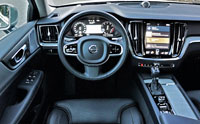
Both use a quick-shifting and highly efficient eight-speed “Geartronic” automatic transmission with manual mode to transfer power to the drive wheels. The new V60 can also be had with available Drive Mode Select that includes Comfort, Eco, Dynamic sport, and Individual driving modes, while fuel-saving and emissions-reducing automatic start/stop, that shuts the engine off when it would otherwise be idling, comes standard. The V60’s official Transport Canada fuel economy rating are 10.2 L/100km in the city, 6.8 on the highway and 8.7 combined for the T5 FWD, or 10.9 city, 7.7 highway and 9.5 with the T6 AWD, which puts it right in the hunt for top efficiency within the ultra-narrow niche known as the compact luxury D-segment wagon category.
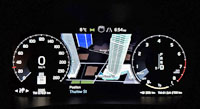
To be clear, the V60 is only up against the BMW 3 Series Touring, the least efficient 2018 model of which bested the most economical V60 by a very slight margin, while turbo-diesel and plug-in hybrid variants were even thriftier, for a price (most expect the 2019 3 Series to be even more of a fuel miser, although they haven’t shown a Touring version yet), whereas the all-new 2019 Mercedes-Benz C-Class Wagon only comes with one engine and driveline so far with no fuel economy specifics yet announced.
The V60’s Dynamic Chassis is comprised of aluminum double wishbones up front and an exclusive integral link rear suspension design featuring a transverse lightweight composite leaf spring, Volvo promising both a comfortable ride and sporty handling from this fully independent setup that we’ll report on in our upcoming review.
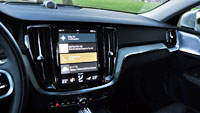
Being a niche model within a shrinking non-crossover/SUV category there aren’t any adaptive suspension options, but those choosing base Momentum trim can swap out the standard Charcoal (black) or Blond (beige) leather upholstery with sharp looking $400 City Weave plaid textile inserts in either colour, while standard Black Stone or Ice White exterior paints can be upgraded to one of nine $900 metallic finishes. Additionally, a set of $1,000 18-inch five Y-spoke diamond cut alloy wheels can be added too, while individual options include a $250 Charcoal headliner, $1,150 graphical head-up display unit, and $1,200 14-speaker, 600-watt Harmon/Kardon audio system.
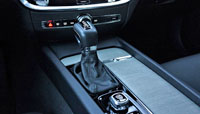
Momentum buyers can also add a $1,250 Climate Package that includes heated Aquablades windshield wipers, a heatable steering wheel, and heated rear seats; a $1,500 Convenience Package with Volvo’s advanced Pilot Assist semi-autonomous drive system featuring Adaptive Cruise Control, plus a Homelink garage door opener and a compass integrated into the rearview mirror; an $1,800 Vision Package with a 360-degree surround parking camera, Park Assist Pilot semi-autonomous self parking, front parking sensors, auto-dimming power-retractable side mirrors, and blindspot monitoring with rear cross traffic alert; and lastly a $3,400 Momentum Plus Package incorporating dynamic cornering headlamps, headlight washers, fog lamps, proximity-sensing keyless access with a hands-free tailgate function that lets you open the liftgate by waving a foot below the rear bumper, the aforementioned 12.3-inch digital instrument cluster, Drive Mode Select, four-zone automatic climate control, navigation (that lets the cruise control access map data for adjusting vehicle speed through corners when appropriate), Road Sign Information, and more.
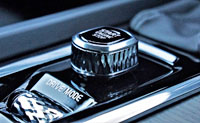
If you opt for the T6 AWD, all of the same standalone options and packages remain, except for wheels that start with a unique set of open-spoke 18-inch alloys as standard equipment and can be upgradable to a set of $1,000 19-inch alloys, while special Amber caramel brown leather becomes an interior option.
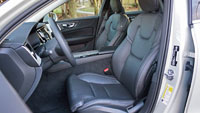
Moving up to $55,400 Inscription trim adds the T6 AWD powertrain as standard equipment, plus a unique chromed waterfall grille, bright metal integrated roof rails, unique 10-spoke 18-inch diamond cut alloy wheels, fog lamps, cornering headlights, a special leather-wrapped and metal edged Inscription key fob, low, medium or high steering assistance via Power Steering Personal Settings, Driftwood decor inlays, the 12.3-inch digital gauge cluster, perforated Nappa leather upholstery, four-way powered lumbar support, ventilated front seats, and more.
Option out a V60 Inscription T6 AWD and you can have special $1,000 19-inch multi-spoke alloys, the aforementioned Charcoal headliner and graphical head-up display, as well as a $3,750 19-speaker 1,400-watt Bowers & Wilkins audio upgrade, and $1,300 massaging front seats. The Momentum Plus Package is no longer offered due to most of it being standard in Inscription trim, but the three remaining Climate, Convenience and Vision packages are still available.
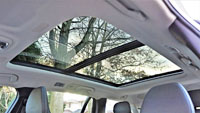
And by the way, all 2019 Volvo V60 pricing was sourced from CarCostCanada, where you can find detailed pricing on trims, packages and standalone options for every other new vehicle sold in Canada, plus otherwise hard to get rebate information and dealer invoice pricing that could save you thousands.
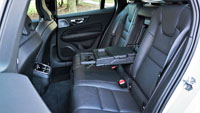
While Momentum and Inscription are the only two trims currently available, we’d like to think that a sportier V60 R-Design will arrive at some point in the near future, which we’d hope would add special 18-inch alloy wheels with the option of unique 19s, plus steering wheel-mounted paddle shifters, and slightly edgier interior and exterior design, while it would incorporate most of the same features offered in the Inscription. Likewise, we hope the V60 will also be available with Volvo’s T8 Twin-Engine powertrain that uses a plug-in hybrid drivetrain to increase engine output to 400 horsepower while reducing fuel consumption considerably. Additionally, the outgoing V60 was also available in factory-built Polestar trim, a car we covered in 2017 guise right here. This was a fabulous performance, so needless to say we’d love to see something similar recreated for this all-new V60.
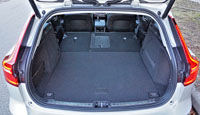
For now we’ll enjoy a double dose of our more luxury-oriented 2019 V60 Inscription for two weeks no less, much thanks to Volvo that provided an extra week of pampering comfort over the holidays. This will give us plenty of time to experience all of its goodness while doing our best to suss out any weaknesses (sorry Volvo). So until our full road test review arrives make sure to peruse our photo gallery above…



